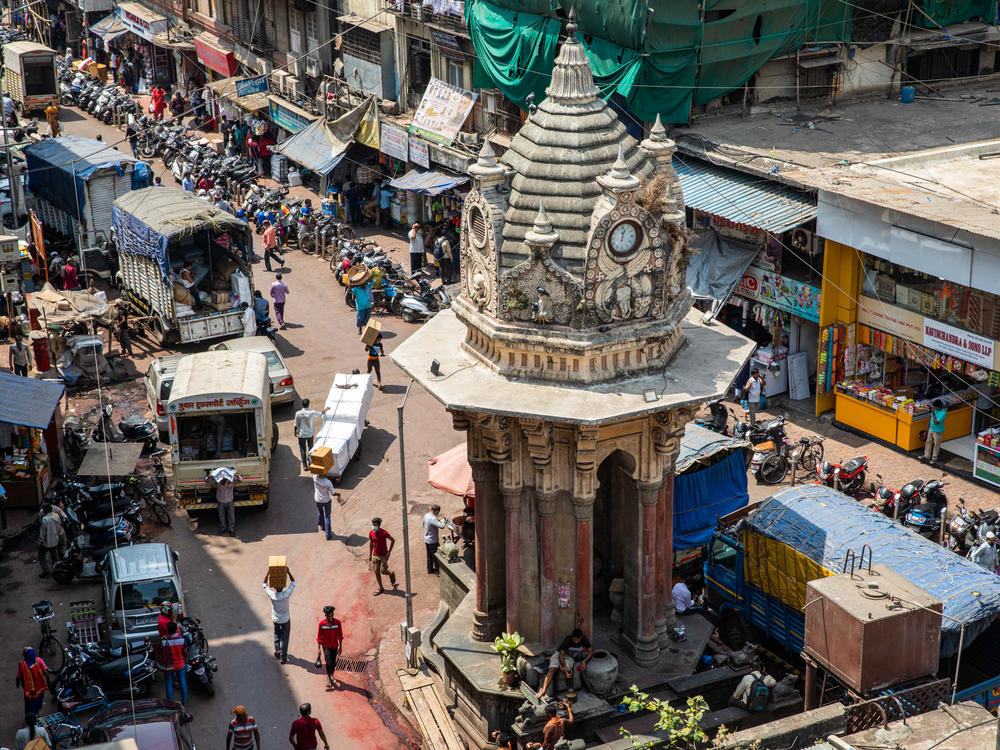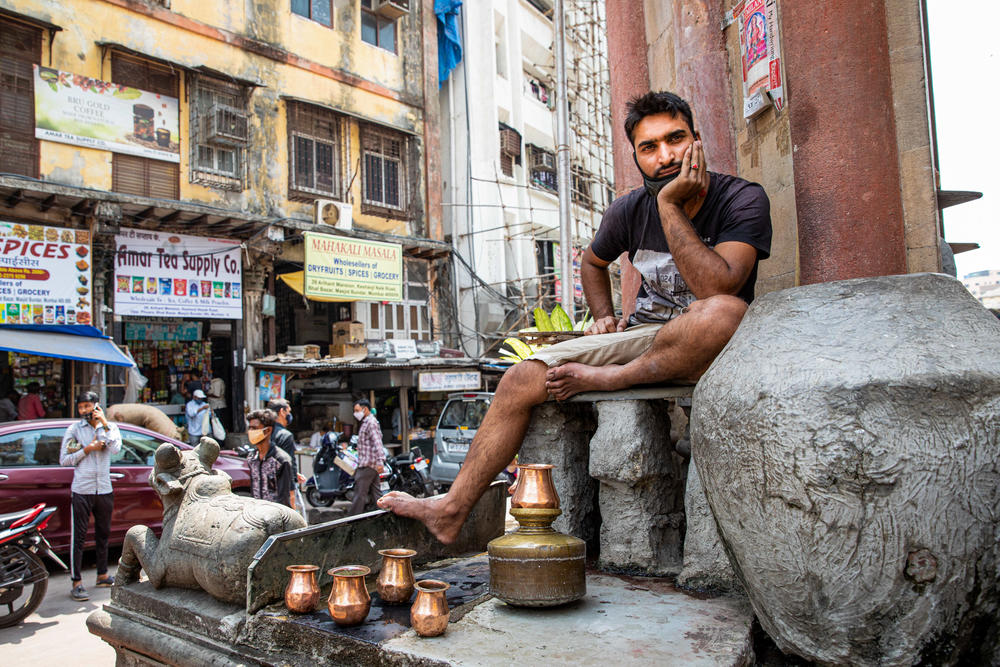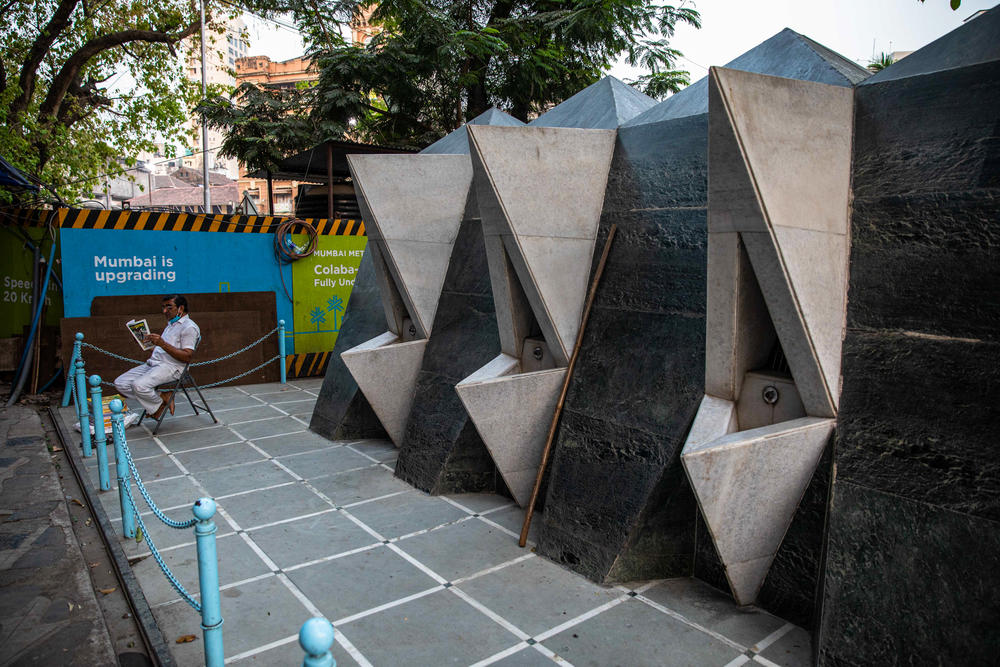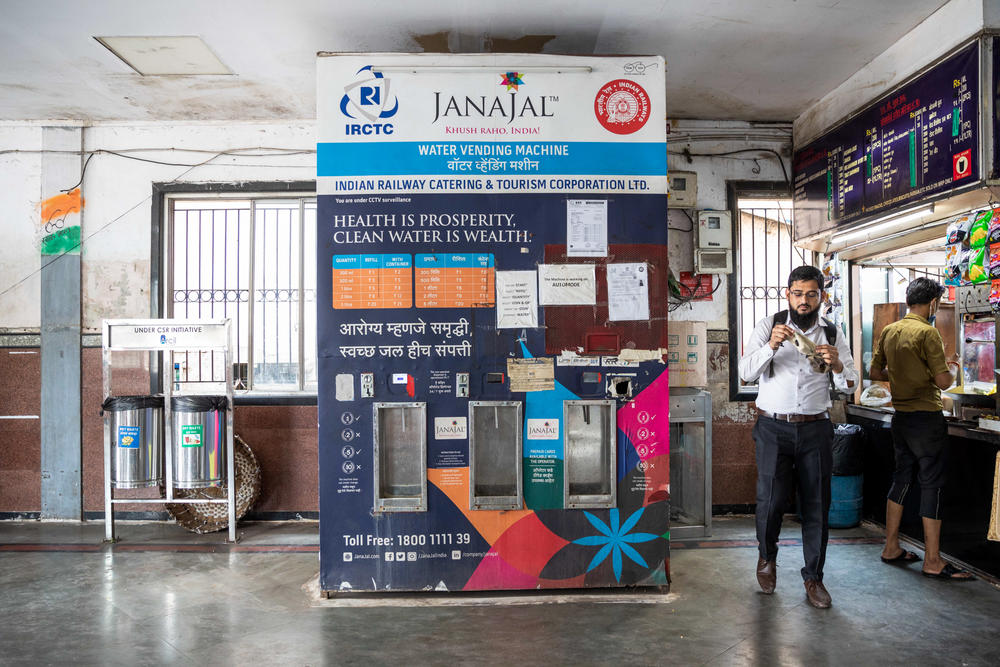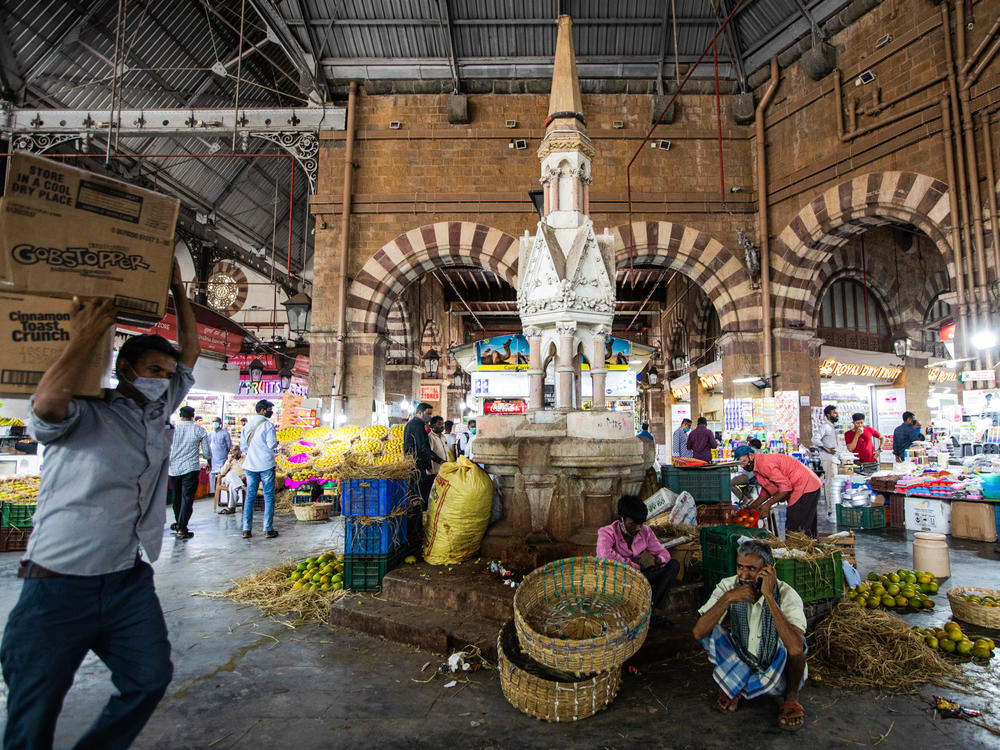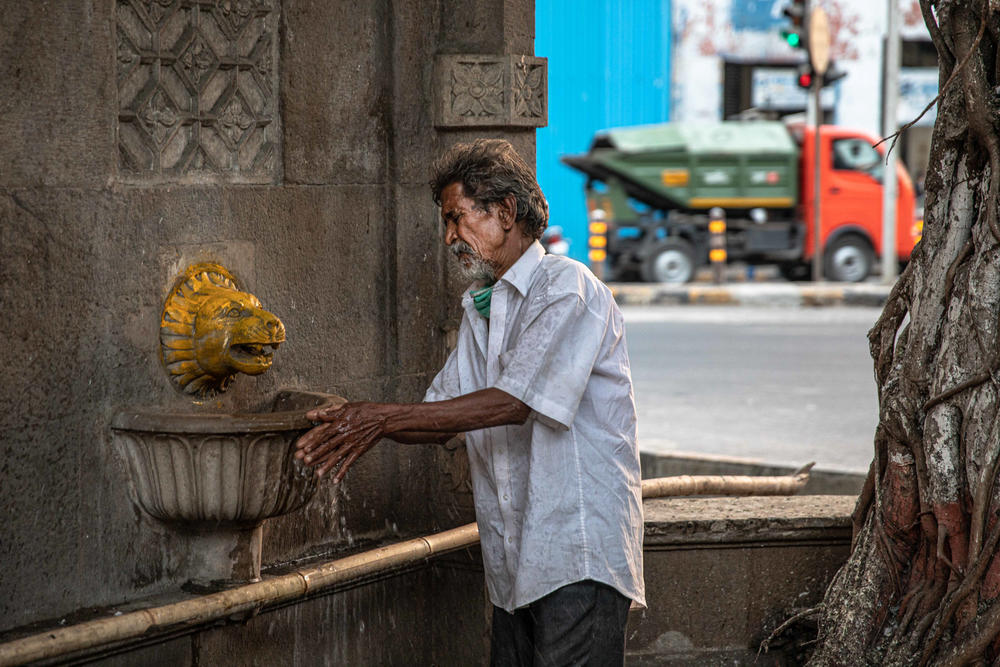Section Branding
Header Content
PHOTOS: Mumbai Falls In Love All Over Again With Its Forgotten Fountains
Primary Content
In a narrow lane near Mumbai's docks, commuters on bicycles weave through the crowd as workers push wooden carts loaded with heavy burlap sacks into warehouses.
Thirty-eight-year-old laborer Mohammad Yaqoob unloads sacks full of marbles from a truck. When he gets tired and thirsty, he walks to an ornate stone structure in the middle of the bustling street. It's a drinking fountain, or pyau (sometimes spelled pyaav), as it's called in the local Hindi and Marathi languages.
"I have a sip of water, rest on the steps for a bit and then get back to work again," says Yaqoob. "This free water is great."
During the British colonial era, wealthy Indian philanthropists — in what was then called Bombay — built these fountains in busy market squares and along Mumbai's tram route as a gift to the community and as memorials for loved ones.
The fountain that Yaqoob says he visits almost every day towers over the street at nearly 30 feet and has an elaborately decorated canopy and pillars. The top of the structure is adorned by an intricate motif of a peacock with its feathers spread out — a symbol of water in Indian culture, says architect Rahul Chemburkar as he gives NPR a tour. It's known as the Keshavji Nayak fountain, after the man who built it nearly 150 years ago and whose bust is carved on the structure.
More than a century ago, water coming from city pipes would flow out of the fountains' decorative spouts continuously. But rampant development and an exponential boom in Mumbai's population — it's now home to 18.4 million — put a strain on water resources.
"The reason why these pyaus went into a little neglect in the 1960s-70s is because the scarcity of water led to stopping of the [constantly] flowing water," says Chemburkar. Water was restricted to a few hours each day. Many of the fountains lacked water storage mechanisms and with the erratic water supply, their spouts ran dry.
One was even accidentally demolished during the construction of a monorail, laments Chemburkar.
The water habits of upper and middle-class residents changed too. Municipal water connections started piping water directly into their homes. "Water became a commercial commodity, and plastic bottled water became popular," says Chemburkar. Most people forgot the fountains.
Now, city officials and conservationists are trying to restore them — an effort driven by a desire to preserve forgotten relics of Mumbai's history but one that can also improve access to water for the city's impoverished.
In 2008, Mumbai's municipal corporation (BMC) commissioned Chemburkar's architecture firm, Vaastu Vidhaan, to restore two pyaus. And in 2015, the BMC's heritage unit identified 30 fountains across the city to be revived as part of a pyau circuit or trail.
The community has embraced the revived Keshavji Nayak fountain renovated in 2015, says Chemburkar. There's a breakfast stall right beside it. People sit on the fountain's steps to read their morning newspaper. Chemburkar estimates at least 50 people visit for a drink each hour.
"It's like a cultural oasis," Chemburkar says.
Steps flanked by statues of bulls, commonly found in Hindu temples, lead up to earthen pots filled with water — now sourced from a municipal water connection beside the structure. A volunteer hands out a metal glass full of water to anyone who comes, regardless of caste or religion.
"In wide contrast, all over the country you see a lot of discrimination over the ownership of water," says Chemburkar. Minority Muslims and members of the Dalit community, considered to be at the bottom of the social hierarchy according to India's ancient caste system, are often beaten up for trying to drink water from a public tap or well. But there's an implicit understanding that the pyaus belong to the entire community, says Chemburkar.
Some of the fountains are even open to animals. The original designs included troughs near the base to collect water that gets spilled over.
Restoring pyaus can also help address huge inequalities in access to Mumbai's water supply, says researcher and activist Purva Dewoolkar. She says more than 2 million people in Mumbai are denied legal water access and face severe water uncertainty.
"[In Mumbai] some people have swimming pools in their homes and on the other hand there's no water to drink," says Dewoolkar, who works with Mumbai-based non-governmental organization Pani Haq Samiti, the Committee for the Right to Water.
A November 2020 report by Dewoolkar and her colleagues found that the city's lowest-income residents — people living in slums and those who were homeless — were spending more on water during the pandemic than before. They were consuming more water because everyone was home and the informal water supply systems that they relied on — like a government water connection in a neighboring housing society or workplaces or schools — were no longer accessible because of the lockdown. So these Mumbai residents had no option but to pool their money for an expensive private tanker-truck and queue up in tight spaces, risking infection from coronavirus, to fill their jerry cans when it delivered water about once a week.
"Their incomes had gone down and in spite of that they were spending more money on water," says Dewoolkar.
"Even as public service announcements were issued reminding people to wash their hands regularly with soap, at least 2 million people in Mumbai wondered how to follow such recommendations without regular, adequate and affordable water access," the report notes.
One of the report's recommendations to the city was to "invest in installing and maintaining many more pyaus in public spaces." That includes less ornate and more recently built fountains too, says Dewoolkar. She sees them as an important public benefit.
In recent years, the city has also installed dozens of water ATMs — metal coolers that automatically dispense drinking water — at railway stations. While they are less expensive than buying plastic bottled water, they're not free. They're also not very aesthetically pleasing, says Chemburkar. He says pyaus are special because they're inviting.
"[The decorative elements] give a lot of dignity to the simple act of drinking water," he says. "Today we actually miss aesthetics in public architecture."
Four pyaus, including the Keshavji Nayak fountain, are functional but the rest are in varying states of disrepair. Trash is strewn beside one of the non-functioning fountains located in a historic colonial-era market. The fountain is about 15 feet high and has spires and a distinctly European style. There are red stains from people spitting betel leaf or paan and tobacco on it.
"[People have] used it like a dustbin," says Chemburkar as he inspects the damage. "I feel agonized but I see opportunity also."
Chemburkar says Mumbai's pyaus have the potential to become unique cultural attractions — similar to Rome's famous waterspouts or nasoni. He says when tourists visit Mumbai, they marvel at its big edifices — grand Gothic architecture with gargoyles and sleek Art Deco buildings — but neglect the small structures that also make the city beautiful.
Chemburkar says pyaus are socio-cultural markers whose architecture is a blend of the many styles found in Mumbai including Victorian and Indo-Saracenic.
The last pyau on Chemburkar's tour is in one of Mumbai's oldest botanical gardens. The fountain is square-shaped with beautiful floral motifs and an arch carved over the spout. A plaque tells visitors it was built in memory of Ardeshir Dadabhoy Dadysett who died in 1912.
Chemburkar says it's next in line to be renovated, with restoration work expected to start within weeks. He says it's scheduled to reopen for thirsty visitors by the end of this year. And when that happens, he has a special way of celebrating.
"I'm going to make it a point that I come here to have that historic water," he says.
Copyright 2021 NPR. To see more, visit https://www.npr.org.
